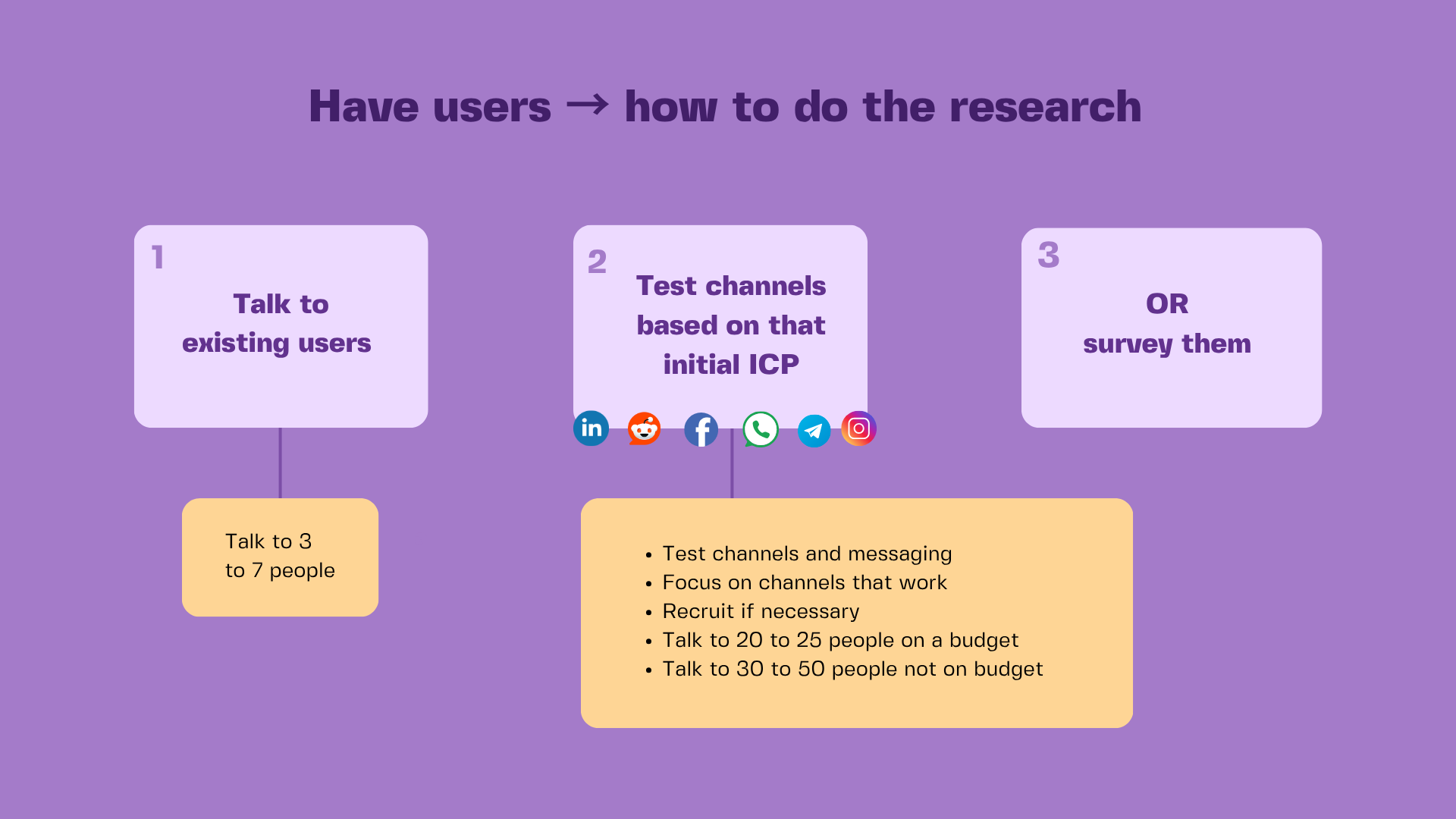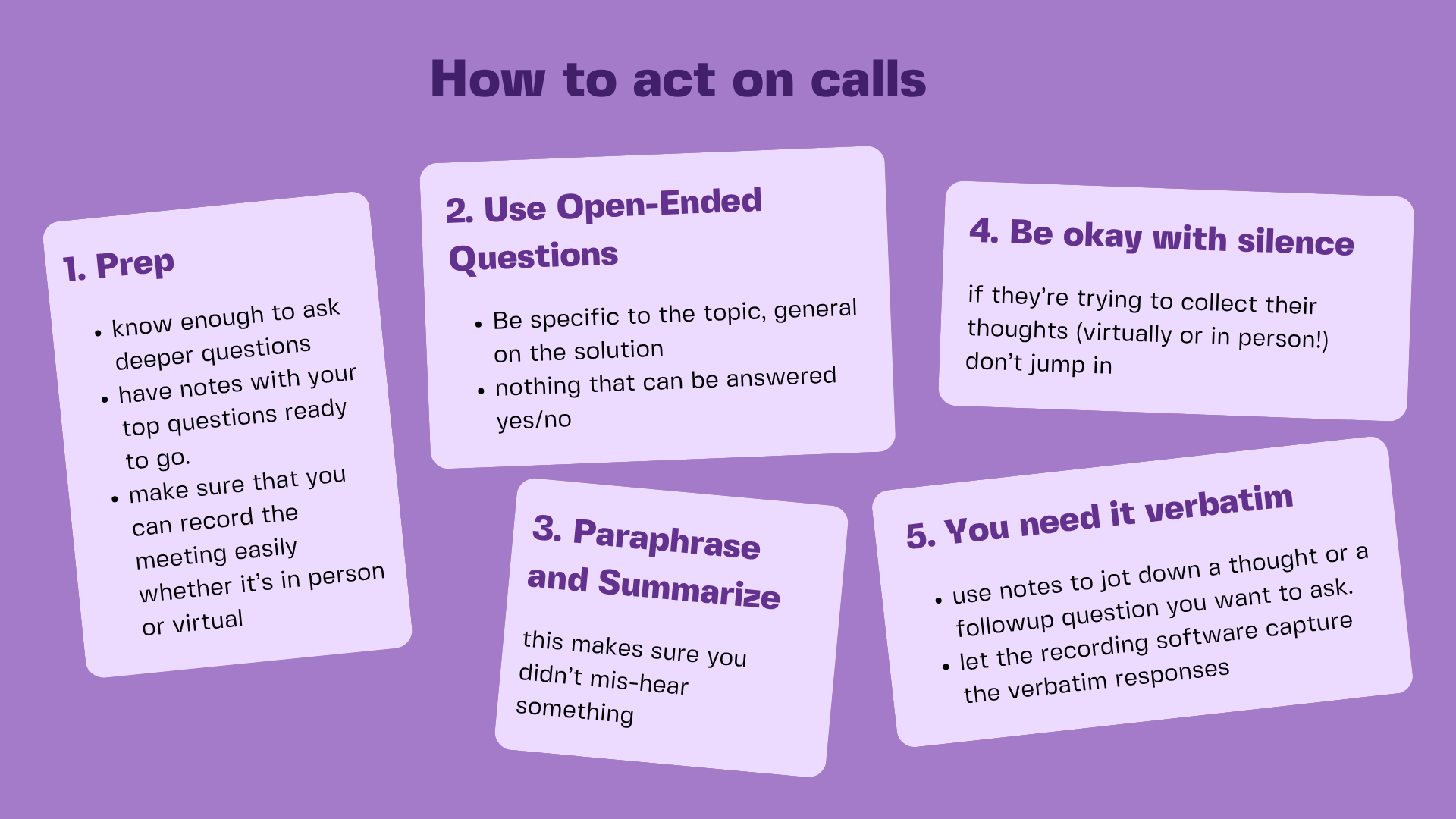How to Do Customer Research (Even If You're Scared to Talk to People)
A no-fluff guide from Sophia & Abhishek on how to start and scale customer research—from zero knowledge to actionable marketing plan.
.png)
.png)
A no-fluff guide from Sophia & Abhishek on how to start and scale customer research—from zero knowledge to actionable marketing plan.
.png)
.png)
Customer research (aka talking to people) is the backbone of your entire company.
When you’re starting out, it’s customer discovery to make sure you’re solving the right problems for the right people. As you get customers, it becomes customer research and user interviews to make sure you’re building for customers. At every step, what you hear from the people you serve turns into new features, better messaging, your north star metrics, marketing campaigns, and positioning. It literally drives the entire business.
Without customers, you don’t have a company. And without talking to people, you’ll never know what to build.
Which is why knowing how to talk to people, really listen to them, and then use what they say in your day-to-day operations is one of the most crucial skills a founder, product marketer, or product manager can have. As a former Chick-fil-A marketing peep, I’d argue it’s your most crucial skill.
So Abhishek and I wrote this nitty, gritty, exceptionally practical guide to help you know what to do when you know you should be doing customer research—but you’re scared to start.
Whether you don’t know who your customer is yet, or you’re sitting on a pile of insights but don’t know what to do with them, this is for you.
Yes, it’s long. Yes, it’s worth bookmarking. And no, you don’t have to wonder how to do customer research ever again.
Great question. Abhishek has been running customer research for us at Ignore No More since 2022 (he was employee #2!) and now owns his own agency, Deep Research, a customer research studio based out of the UK and India.
He has probably spoken with over 40,000 people (yes, really) and run more than 1,750 customer interviews in the last two years alone. When I say he knows how to talk to people, I mean it.
Most resources on customer research are too fluffy or too academic to be useful when you’re just starting out—especially when you’re building something tied to your identity and your dreams. This guide is the opposite. It’s pure: Do this. Then do that.
Let’s dive in.
When you’re starting from scratch, it’s all ✨vibes✨ and intuition. You might feel overwhelmed because you don’t know the problem you’re solving or who you’re solving it for. But here’s the good news: you can use that to your advantage.
Start by figuring out what you don’t know. This is your "1:many" stage. That means you’re not interviewing yet—you’re listening. Lurking. Observing. You're looking for people talking about the problems you want to solve, even if they aren’t talking to you.
Head to places like Reddit, forums, and review sites. Read what people are complaining about. Look at how they describe their pain points and what language they use. Use tools like Google Keyword Planner, Ahrefs, or SEMrush to understand what people are actually searching for.
Still feeling unsure? Ask ChatGPT for alternative audiences around the problem you want to solve. Seriously, we do this all the time.
Once you’ve gathered some insight, you should be able to answer:
If you can’t answer those yet, don’t panic. Just go back, refine your problem statement, and repeat the process.
.png)
If you already have some users—even just a few—start by talking to them. Seriously. This is gold.
Talk to 3–7 of your existing customers to understand who they are and why they’re using your product. What problems were they trying to solve? Why did they pick you? What were they doing before?
Then use what you hear to test messaging and channels. Start small. Where do people like them hang out online? Try LinkedIn, Slack groups, Facebook groups, Reddit, niche forums—wherever your people spend time.
Pro tip: Hive Index is a great tool to find communities by profession, interest, or topic.

You don’t need a list of 10,000 people to get started. In fact, you shouldn’t.
In the first two weeks, your job is to test messaging and channels. Once you start seeing consistent responses from one or two channels, focus your energy there. That’s where your message is landing—that’s your message-market fit.
If your audience includes professionals with hourly rates (think: lawyers, therapists, execs), you may need to recruit and compensate interviewees. Expect to pay $100–$150 per person, possibly more for C-suite roles.
If you’re on a budget or narrowing in on a specific use case, aim to talk to 20–25 people. If you’ve got some breathing room, 30–50 is better. More than 50? You’re probably just hearing the same stories on loop.
And a word to the wise: do not mix sales and research. If you use research calls to pitch, people will shut down or tell you what you want to hear. That’s not data. That’s noise.
.png)
Nervous about your first few calls? Totally normal. Here’s what helps:
1. Prep: Have your questions written down. Know enough about the person to ask meaningful follow-ups. Make sure you can record the session so you can focus on the convo, not your keyboard.
2. Ask open-ended questions: Avoid yes/no questions. You want stories, not soundbites. Be specific to the topic but general about the solution.
3. Paraphrase and summarize: Repeat back what you heard. This keeps you from misinterpreting and shows them you’re listening.
4. Be okay with silence: Some of the best answers come when you let the pause linger. Don't rush to fill the space.
5. Capture it verbatim: Jot down quick notes and let your recording tool do the rest. Verbatim phrases are marketing gold.
Start each interview with a personal question to break the ice ("What’s your favorite movie franchise?" is a favorite of ours). Then move into work, workflow, community, and end with something fun. The goal is to humanize the person, not turn them into a spreadsheet.

This depends on what you want to learn, but generally:
Don’t be afraid to go a little off-script if the convo is rich. Some of our best insights came from rabbit holes we didn’t plan to go down.
.png)
You did the interviews. Now what?
Make a spreadsheet. (Or Airtable if you’re fancy.) Each row is an interview. Each column is a question or theme. Add tags for things like features, use cases, pain points. Pull out great lines and phrases in a dedicated notes column.
Then look for patterns. What are people asking for? What’s a recurring complaint about competitors? What do they say that lights up when you read it?
For us, the first 15 indiehacker coffee chats turned into the ticker copy on our homepage. No joke.
Now that you have the insights, it’s time to put them to use. This part often gets skipped, but it’s where all the magic happens.
Here’s how:
.png)
YOU’RE NEVER DONE!!!
mischievous laugh, lightning cracks
But really: you can pause when you can clearly answer:
When you can answer those with real data and real quotes, you’re ready to build and market with confidence.
Abhishek and I can help you know your customers inside and out and build a clear, research-backed marketing plan in 45 days flat.
Book a call here: https://cal.com/sophia-o-neal/lets-talk
Or just buy us a coffee and say thanks: Buy Me a Coffee ☕






We’ll be in touch in a jiffy to get your company’s marketing sparkly and spiffy.